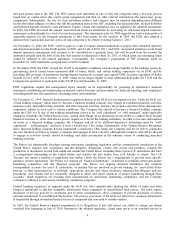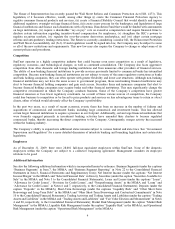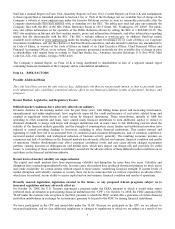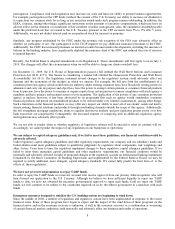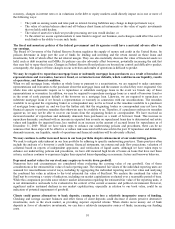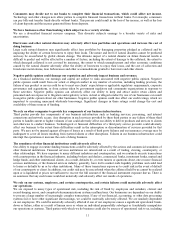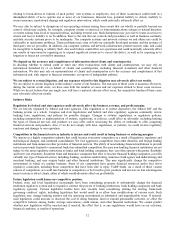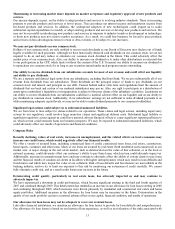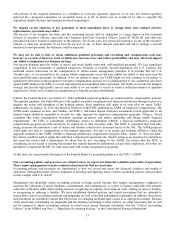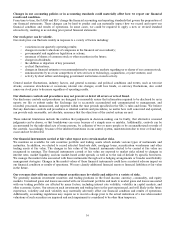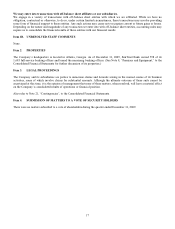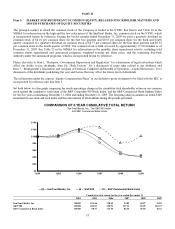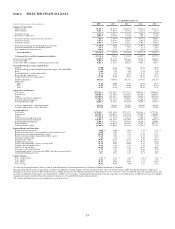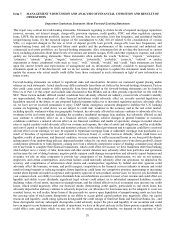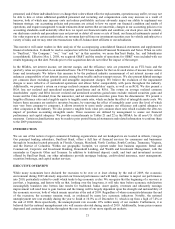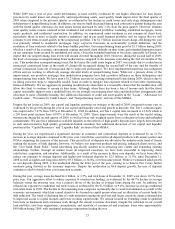SunTrust 2009 Annual Report Download - page 30
Download and view the complete annual report
Please find page 30 of the 2009 SunTrust annual report below. You can navigate through the pages in the report by either clicking on the pages listed below, or by using the keyword search tool below to find specific information within the annual report.our loan portfolio, including the size and composition of the loan portfolio, current economic conditions and geographic
concentrations within the portfolio. The current stress on the United States economy and the local economies in which we do
business may be greater or last longer than expected, resulting in, among other things, greater than expected deterioration in
credit quality of our loan portfolio, or in the value of collateral securing these loans. Our allowance for loan losses may not
be adequate to cover eventual loan losses, and future provisions for loan losses could materially and adversely affect our
financial condition and results of operations.
We will realize future losses if the proceeds we receive upon liquidation of nonperforming assets are less than the
carrying value of such assets.
Nonperforming assets are recorded on our financial statements at the estimated net realizable value that we expect to receive
from holding and ultimately dispensing of the assets. Deteriorating market conditions could result in a realization of future
losses if the proceeds we receive upon dispositions of nonperforming assets are less than the carrying value of such assets.
Disruptions in our ability to access global capital markets may negatively affect our capital resources and liquidity.
In managing our consolidated balance sheet, we depend on access to global capital markets to provide us with sufficient
capital resources and liquidity to meet our commitments and business needs, and to accommodate the transaction and cash
management needs of our clients. Other sources of funding available to us, and upon which we rely as regular components of
our liquidity risk management strategy, include inter-bank borrowings, repurchase agreements, and borrowings from the
Federal Reserve discount window. Any occurrence that may limit our access to the capital markets, such as a decline in the
confidence of debt purchasers, our depositors or counterparties participating in the capital markets, or a downgrade of our
debt rating, may adversely affect our capital costs and our ability to raise capital and, in turn, our liquidity.
In 2009 and 2010, credit rating agencies downgraded the credit ratings of SunTrust Bank and SunTrust Banks, Inc.
These downgrades and any subsequent downgrades could adversely impact the price and liquidity of our securities
and could have an impact on our businesses and results of operations.
Our credit ratings are an important factor in determining both the available volume and the cost of our wholesale funding. On
March 5, 2009, Fitch lowered the credit ratings for SunTrust Banks, Inc. and SunTrust Bank from A+/F-1 to A-/F-1. On
April 23, 2009, Moody’s downgraded the senior credit ratings for SunTrust Banks, Inc. and SunTrust Bank from A1/P-1 and
Aa3/P-1, respectively, to Baa1/P-2 and A2/P-1, respectively. On April 28, 2009, S&P downgraded the credit ratings for
SunTrust Banks, Inc. and SunTrust Bank from A/A-1 and A+/A-1, respectively to BBB+/A-2 and A-/A-2, respectively. On
February 1, 2010, S&P downgraded SunTrust Banks, Inc’s. credit ratings to BBB/A-2 and SunTrust Bank’s credit ratings to
BBB+/A-2. Our credit ratings remain on “Negative” outlook with Moody’s and Fitch, while S&P maintains a “Stable”
outlook on our ratings. Additional downgrades are possible. Where our bank subsidiaries are providing forms of credit
support such as letters of credit, standby lending arrangements or other forms of credit support, a decline in short-term credit
ratings may prompt customers of our bank subsidiaries to seek replacement credit support from a higher rated institution. In
April 2009, we experienced a downgrade which affected a part of our business which we discuss in the “Management’s
Discussion and Analysis – Liquidity Risk” section below. We cannot predict whether existing customer relationships or
opportunities for future relationships could be further affected by customers who choose to do business with a higher rated
institution.
We have in the past and may in the future pursue acquisitions, which could affect costs and from which we may not
be able to realize anticipated benefits.
We have historically pursued an acquisition strategy, and intend to continue to seek additional acquisition opportunities. We
may not be able to successfully identify suitable candidates, negotiate appropriate acquisition terms, complete proposed
acquisitions, successfully integrate acquired businesses into the existing operations, or expand into new markets. Once
integrated, acquired operations may not achieve levels of revenues, profitability, or productivity comparable with those
achieved by our existing operations, or otherwise perform as expected.
Acquisitions involve numerous risks, including difficulties in the integration of the operations, technologies, services and
products of the acquired companies, and the diversion of management’s attention from other business concerns. We may not
properly ascertain all such risks prior to an acquisition or prior to such a risk impacting us while integrating an acquired
company. As a result, difficulties encountered with acquisitions could have a material adverse effect on the business,
financial condition, and results of operations.
Furthermore, we must generally receive federal regulatory approval before we can acquire a bank or bank holding company.
In determining whether to approve a proposed bank acquisition, federal bank regulators will consider, among other factors,
the effect of the acquisition on competition, financial condition, future prospects, including current and projected capital
levels, the competence, experience, and integrity of management, compliance with laws and regulations, the convenience and
needs of the communities to be served, including the acquiring institution’s record of compliance under the CRA, and the
effectiveness of the acquiring institution in combating money laundering activities. In addition, we cannot be certain when or
if, or on what terms and conditions, any required regulatory approvals will be granted. Consequently, we might be required to
14


